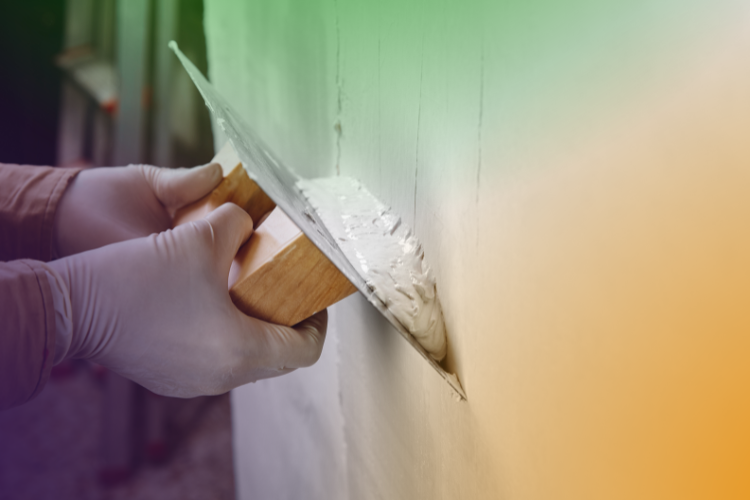When it comes to renovating or building, plastering is a fundamental skill that ensures your walls and ceilings are smooth, durable, and ready for decoration. Whether you're a DIY enthusiast or a professional tradesperson, understanding the terminology used in plastering can make a significant difference in the quality of your work.
In this comprehensive A-Z plastering glossary, we'll explore key terms and concepts to help you navigate the world of plastering with confidence and precision. From the basics of bonding agents to the intricacies of Venetian plaster, this guide is your go-to resource for all things plastering. Let's dive in and get acquainted with the essential vocabulary that every plasterer should know.
A
- Accelerator: An additive used to speed up the setting time of plaster.
- Admixture: Any material added to plaster to change its properties.
- Air Lime: Lime that sets and hardens by reacting with carbon dioxide in the air.
- Artex: A textured surface finish for interior walls and ceilings, popular in the 1970s and 1980s.
- Asbestos: A hazardous material that was historically used in some plasters for fireproofing.
- Asturian Knife: A wide, flexible knife used for smoothing plaster surfaces.
B
- Backing Coat: The initial layer of plaster applied to a surface to provide a base for subsequent coats.
- Bag Rub: A finishing technique where a damp hessian bag is rubbed over the surface to smooth it.
- Base Coat: Another term for the first layer of plaster applied to a surface.
- Beading: Metal or plastic strips used to reinforce edges and corners of plasterwork.
- Bonding Agent: A substance applied to a surface to improve adhesion of plaster.
- Bonding Plaster: A type of undercoat plaster used for its strong adhesive properties.
- Browning Plaster: An undercoat plaster used on surfaces such as bricks and blocks.
C
- Cement Plaster: A mixture of cement, sand, and water used as a base coat.
- Coving: Decorative plaster moulding installed where the wall meets the ceiling.
- Cracking: The formation of fissures in plaster due to shrinkage or movement.
- Crowning: A raised area in plaster caused by excessive material build-up.
- Curing: The process of allowing plaster to set and harden over time.
- Cutting In: Applying plaster around edges and corners with precision.
D
- Dabbing: The process of applying dabs of adhesive to fix plasterboard to walls.
- Dash Coat: A preparatory coat of rough material to help subsequent plaster coats adhere.
- Dot and Dab: A method of attaching plasterboard to walls using adhesive dabs.
- Dry Lining: Fixing plasterboard to walls or ceilings without the use of wet plaster.
- Drywall: Another term for plasterboard, commonly used in dry lining.
- Durability: The ability of plaster to withstand wear and damage over time.
E
- Efflorescence: White, powdery deposits on plaster caused by salt migration.
- Erosion: The wearing away of plaster due to weathering or abrasion.
- Expanded Metal Lath: A metal mesh used as a base for plastering over wooden studs or masonry.
F
- Feathering: Smoothing the edges of plaster to create a seamless transition.
- Fibrous Plaster: Decorative plaster mouldings made with plaster reinforced by fibres.
- Finish Coat: The final, smooth layer of plaster applied to a surface.
- Float: A flat tool used to smooth and level plaster.
- Floating: The process of leveling and smoothing the first coat of plaster.
- Float and Set: Applying a backing coat (float) and a finish coat (set) of plaster.
- Flanking Strip: Insulating material placed around the perimeter of a room before plastering.
G
- Gauging Trowel: A small trowel used for mixing plaster and applying it in small quantities.
- Gesso: A type of plaster used as a base for gilding or painting.
- Gypsum Plaster: Plaster made from gypsum, commonly used for interior surfaces.
H
- Hairline Cracks: Very fine cracks that appear on the plaster surface.
- Hardwall Plaster: A type of backing plaster known for its toughness and durability.
- Hawk: A flat, handheld tool used to hold plaster during application.
- Hessian Tape: A woven fabric tape used to reinforce plaster joints and prevent cracking.
I
- Impact Resistance: The ability of plaster to withstand physical impacts without damage.
- Insulating Plaster: Plaster with added insulating properties to improve thermal performance.
J
- Jointing Compound: A filler used to seal joints between plasterboards.
- Junction: The point where two plaster surfaces meet, such as a wall and ceiling.
K
- Key: The roughness of a surface that allows plaster to adhere properly.
- Knauf: A leading brand of plaster and plasterboard products.
L
- Lath: Thin strips of wood or metal used as a base for plaster.
- Lime Plaster: Plaster made from lime, sand, and water, known for its flexibility and breathability.
- Lime Putty: A creamy paste made from slaked lime, used in lime plaster.
- Lining Paper: Paper applied to walls before painting to create a smooth surface.
M
- Marble Plaster: A decorative plaster finish that mimics the appearance of marble.
- MDF (Medium Density Fibreboard): An engineered wood product often used as a base for plastering.
- Mesh Tape: A fibreglass tape used to reinforce plaster joints and prevent cracking.
- Mixing Paddle: A tool used to mix plaster to a smooth consistency.
- Moulding: Decorative plaster features such as cornices and coving.
N
- Nib: A small protrusion on a plaster surface, often requiring sanding or cutting.
- Non-Hydraulic Lime: Lime that sets by reacting with carbon dioxide in the air, not water.
O
- Overskim: Applying a thin layer of plaster over an existing plaster surface to smooth it out.
P
- Parging: Applying a coat of plaster or mortar to a wall for waterproofing or insulation.
- Pebble Dash: A rough exterior wall finish made by throwing pebbles onto wet plaster.
- Plaster: A mixture of gypsum, lime, or cement used for coating walls and ceilings.
- Plasterboard: A panel made of gypsum plaster pressed between two sheets of paper, used for dry lining.
- Plastering Sand: Fine sand used in the preparation of plaster mixes.
- Plaster of Paris: A quick-setting gypsum plaster used for casting and moulding.
- Polished Plaster: A decorative finish that creates a smooth, glossy surface.
- Primer: A preparatory coating applied to a surface before plastering.
Q
- Quoin: Decorative plaster blocks or stones at the corner of a building.
R
- Rabbiting: The process of mixing lime with animal hair to reinforce plaster.
- Reinforcement: Materials like mesh or fibres added to plaster to improve strength.
- Rendering: Applying a coat of plaster to external walls.
- Re-skimming: Applying a thin layer of plaster over an existing plaster surface.
- Roughcast: A coarse exterior wall finish made by throwing a mixture of plaster and aggregate onto the wall.
- Running Mould: A tool used to create continuous decorative plaster mouldings.
S
- Screed: A thin layer of plaster applied to a floor or wall to level it.
- Scratch Coat: The first coat of plaster applied to a surface, scored to provide a key for subsequent coats.
- Setting Time: The time it takes for plaster to harden after application.
- Silicone Render: A render that includes silicone to improve water resistance and flexibility.
- Skimming: Applying a thin layer of finishing plaster to create a smooth surface.
- Slaking: The process of adding water to quicklime to create lime putty.
- Solid Plastering: Plastering directly onto masonry or other solid surfaces.
- Stucco: A decorative plaster finish for walls, both interior and exterior.
- Stud Wall: A partition wall made from timber or metal studs and covered with plasterboard.
T
- Taping: Applying tape to plasterboard joints before plastering to create a seamless finish.
- Tanking: Applying a waterproof coating to walls to prevent moisture penetration.
- Trowel: A flat-bladed tool used for applying and smoothing plaster.
- Trowel Marks: Lines left in plaster by a trowel, usually smoothed out during finishing.
- Troweling Up: The final smoothing of plaster with a trowel as it begins to set.
U
- Undercoat: The first layer of plaster applied to a surface.
- Undercutting: Cutting away part of a surface to create a key for plaster.
V
- Venetian Plaster: A polished plaster finish that mimics the look of polished marble.
- Vermiculite Plaster: Plaster that contains vermiculite for improved insulation and fire resistance.
W
- Wattle and Daub: A traditional method of building walls using woven wooden strips (wattle) coated with a plaster mixture (daub).
- Wet Plastering: The process of applying plaster directly onto walls and ceilings, as opposed to using plasterboard.
- Whip: A tool used to mix plaster by hand.
- White Set: A finishing plaster that is white in colour, often used for a smooth finish.
X
- X-Ray Plaster: Plaster that provides radiation shielding, used in medical facilities.
Y
- Yellowing: Discolouration of plaster over time, often due to moisture or poor-quality materials.
Z
- Zinc Oxide: An additive used in some plasters to prevent mildew and increase durability.



